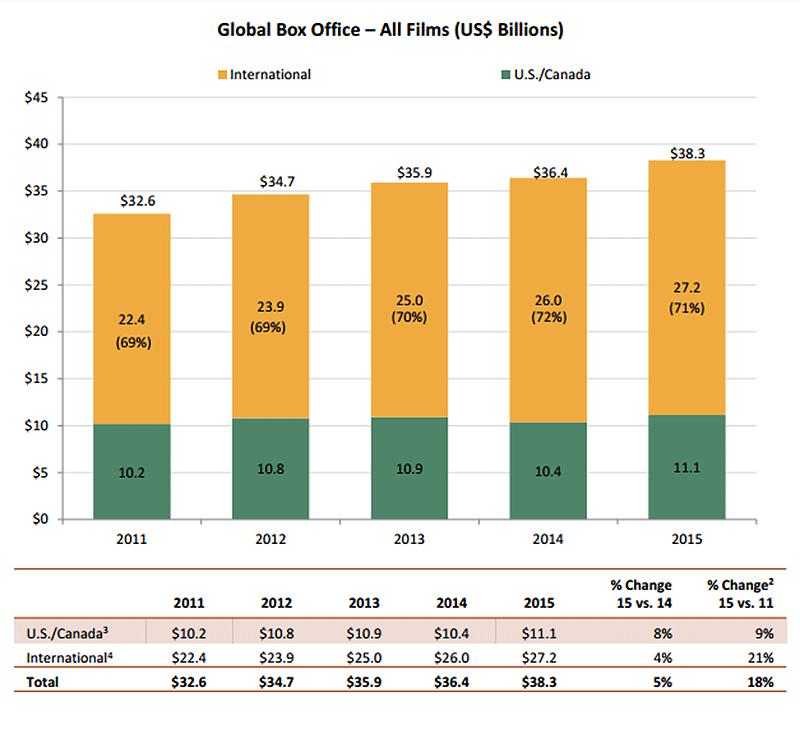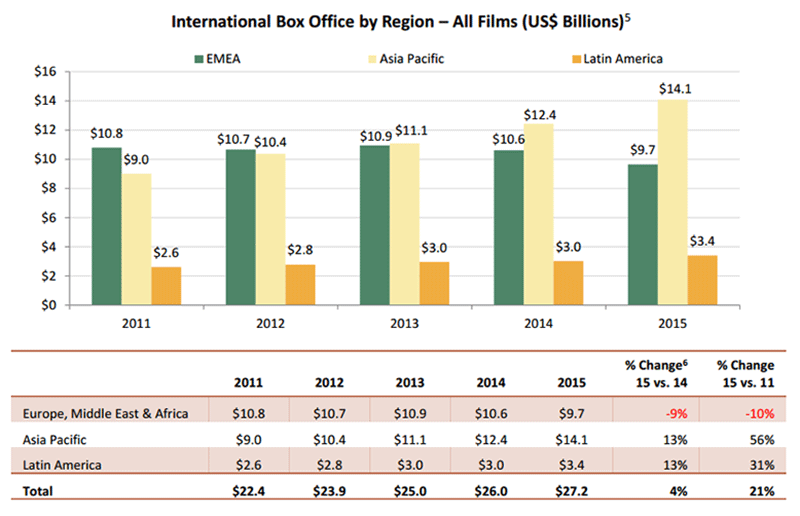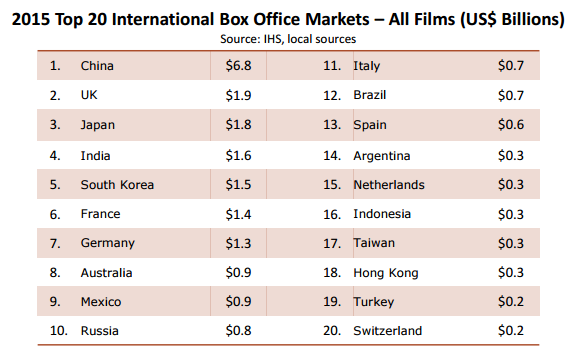Global Revenue Trends

GLOBAL REVENUE TRENDS IN THE MOTION PICTURE INDUSTRY: 2015-16
“This global record proves that going to the movies is a beloved pastime that is enjoyed throughout the world, with moviegoers from a wide array of backgrounds and cultures all coming together for the shared in-theatre experience - providing the collective horsepower to push the industry near the $40 billion mark for the first time.” - Paul Dergarabedian, Senior Media Analyst, Rentrak By Arindam Bhunia Hollywood (above) by Zuschnitt The film industry or motion picture industry comprises the technological and commercial film institutions of filmmaking, i.e., film production companies, film studios, cinematography, film production, screenwriting, pre-production, post production, film festivals, film distribution; and actors, film directors, and other film crew personnel.
In the first edition of Cult Critic, we will discuss the scenario of box office film market trends of motion pictures around the world. Currently, the largest box office film markets around the world are occupied by the United States, China, the United Kingdom, Japan, and India; and the countries with the largest number of film productions are India, Nigeria, and the United States. Whereas Hong Kong, the United Kingdom, France, Italy, Spain, and Germany are the countries that lead movie production. The worldwide theatrical film market had a box office accumulation of $38.3 billion US dollars in 2015. The top three continents/regions by box office gross were: Asia-Pacific with US: $14.1 billion, North America with US: $11.1 billion, and Europe, the Middle East, and North Africa with US: $9.7 billion. 
1. Values in the report include all films released, regardless of film distributor or country of origin, except where specified as a subset. 2. Percentage value change is calculated using table values before rounding. 3. Source: comScore – Box Office Essentials, calendar year from January 1-December 31. 4. International box office country-by-country based on a variety of primary and secondary data sources. Global box office revenue grew from 23.1 billion US dollars in 2005 to 38 billion in 2014 and the positive development is expected to continue at least until 2018, when revenue is forecast to reach 45.9 billion. The US market is also projected to experience an undisturbed growth period, reaching 12.5 billion in 2018, up from 10.4 billion in 2012. This amount made the United States the largest box office film market in the world, leaving other wealthy and/or populous countries far behind. The graph shows box office revenues in various world regions from 2011 to 2015.

In 2015, U.K. was the second-largest film market, with box office revenue of 1.9 billion U.S. dollars, and box office film revenue is expected to reach 48.4 billion U.S. dollars by 2019. The box office is a measurement of the total gross of tickets sold for a particular movie, essentially the revenue from ticket sales. In the film industry, box office sales values are significant to assess how successful a movie is. On a worldwide scale, China leads all other international box office film markets worldwide, having earned 6.8 billion U.S. dollars of revenue, followed by the U.K with 1.9 billion U.S. dollars and then Japan with 1.8 billion U.S. dollars. A possible reason for such a large revenue differential could be the film production of the most popular movies in Hollywood and major movie festivals taking place in the United States. Higher North American revenues could be attributed to not only higher interest but also higher movie ticket prices. In the U.S. and Canada, the average movie ticket price amounted to 8.43 U.S. dollars in 2015. This is a value that has significantly increased over the past decade. A ticket in 2006 cost 6.55 U.S. dollars, so in approximately 9 years, the average cost of a movie ticket had risen by roughly two U.S. dollars.

5. Box office data is in U.S. dollars for analytical and comparative purposes. Local currency box office trends may differ due to exchange rate fluctuations. 6. Percentage value change is calculated using table values before rounding. Ernst and Young recently predicted that China would overtake the US as the world’s largest film market in 2020, but perhaps it could be even sooner. China’s growth is being generated by an ever-expanding number of screens, with 25,000 being added in the next five years, and by the increasing number of foreign films authorized for release. The country’s enthusiasm for Hollywood films can massively increase their profitability, or help flop movies turn into hits. As per a report from PwC, the worldwide revenue will grow from 38.3 billion U.S. dollars in 2015 to 49.3 billion in 2020.
GLOBAL BOX OFFICE REVENUE FROM 2016 - 2020

The past decade has seen no shortage of doomsday scenarios put forth for the box office, but the threats from piracy and online streaming services have yet to play out in global ticket sales. That's partially because worldwide performance has masked domestic box office totals that have been relatively stagnant over the past five years, with increases in ticket prices making up for a decline in ticket volume. It does seem probable that a wider range of entertainment alternatives is contributing to the lack of domestic box office growth. As movie chains aim to distinguish their entertainment offerings through premium screens, smaller pictures are having a harder time standing out at multiplexes but finding ample new avenues through online film distribution. Small to mid-budget movies are reaching large audiences on platforms like Netflix and Amazon Prime. These companies are pushing into original content themselves and, when combined with other favorable film industry trends, mean there is more money in the film industry than ever.
Arindam Bhunia is a marketing manager in an MNC with more than eight years of work experience in electrical field. Apart from his corporate job, he has interest in cultural activities so he joined Human Lab Corporation as Chief Executive Officer. He oversees strategic planning for film, television and video game production, marketing and distribution for the company’s business verticals worldwide. He is also responsible for overseeing finance, legal, labour relations, technology and HLC Studio operations.


